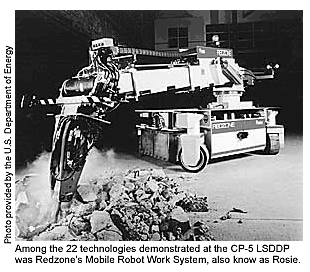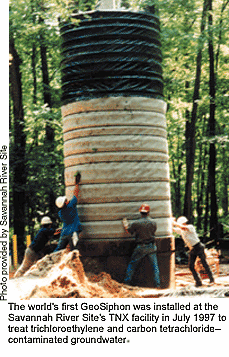|

 OST
achievements among DOE’s most significant OST
achievements among DOE’s most significant
A panel of citizen judges has selected several Office
of Science and Technology accomplishments as being among DOE’s
top scientific and technological achievements since the department
was formed 23 years ago. From nominations submitted by DOE sites and
laboratories, the judges selected the 100 most notable achievements
in terms of contributing to society by helping consumers save money
and improve the quality of life. The innovations honored with Energy
100 Awards have come from two traditional DOE missions—the energy
and environment sectors.
OST programs and initiatives have contributed to the development or
deployment of the following Energy 100 Award winners:

- Soft-Sided Waste Containers (Tech
ID 2240) offer an
8-to-1 cost savings over plywood or metal boxes. They are also more
volumetrically efficient and easier to use, and they reduce future
landfill settling, sinking, and breaching of landfill caps (see
Initiatives, Spring 1999).
- PHOSter® (Tech
ID 2971) provides controlled addition of phosphate to sites
contaminated with organic compounds, speeding up the natural process
of contaminant degradation through bioremediation (see
Initiatives, December 1996).
- BOA (Tech
ID 148) is a robot that remotely strips and bags asbestos material
from pipes, reducing risk for workers (see
Initiatives, June 1997).

- CP-5 Large-Scale Demonstration and Deployment Project,
at the Chicago Pile 5 (CP-5) Research Reactor facility at Argonne
National Laboratory, was the first large-scale demonstration
and deployment project (LSDDP) to be completed and was the venue
for demonstrating 22 innovative D&D technologies. OST’s
D&D Focus Area undertook
this LSDDP as part of its strategy to demonstrate innovative D&D
technologies alongside baseline commercial technologies as part
of an actual full-scale environmental management project (see Initiatives,
Summer 1998).
- GeoSiphon/Geoflow Groundwater Treatment (Tech
ID 2063) is a passive, in situ groundwater treatment system,
which takes advantage of natural gradient and pressure differences
to induce contaminated groundwater to flow at an accelerated rate
through a permeable reactive medium (see
Initiatives, Spring 2001).
|

 OST
achievements among DOE’s most significant
OST
achievements among DOE’s most significant
